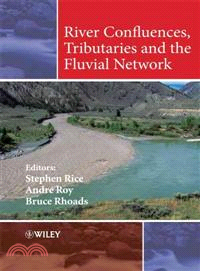River Confluences, Tributaries And The Fluvial Network
商品資訊
ISBN13:9780470026724
出版社:John Wiley & Sons Inc
作者:Rice
出版日:2008/07/25
裝訂/頁數:精裝/474頁
定價
:NT$ 5216 元優惠價
:90 折 4694 元
若需訂購本書,請電洽客服 02-25006600[分機130、131]。
商品簡介
目次
相關商品
商品簡介
River Confluences and the Fluvial Network brings together state of the art thinking on confluence dynamics tributary impacts and the links between processes at these scales and river network functions. The book is unique in focus, content, scope and in bringing together engineering, ecological and geomorphological approaches to the three key areas of river system science.
Taking a global approach this multi-authored text features a team of carefully selected, internationally renowned, experts who have all contributed significantly to recent ground breaking advancements in the field. Each chapter includes a comprehensive review of work to date highlighting recent discoveries and the main thrust of knowledge, previously unpublished research and case studies, challenges and questions, detailed references as well as a forward looking assessment of the state of the science.
* multi-authored work written by well respected international experts in the field
* Includes previously unpublished research and case studies.
* global examples to illustrate the various approaches to the study of confluences and networks
* Overlap between chapters to ensure continuity.
*
Each new subject begins with comprehensive review of work to date
Taking a global approach this multi-authored text features a team of carefully selected, internationally renowned, experts who have all contributed significantly to recent ground breaking advancements in the field. Each chapter includes a comprehensive review of work to date highlighting recent discoveries and the main thrust of knowledge, previously unpublished research and case studies, challenges and questions, detailed references as well as a forward looking assessment of the state of the science.
* multi-authored work written by well respected international experts in the field
* Includes previously unpublished research and case studies.
* global examples to illustrate the various approaches to the study of confluences and networks
* Overlap between chapters to ensure continuity.
*
Each new subject begins with comprehensive review of work to date
目次
Preface.
List of contributors.
1. Introduction: river confluences, tributaries and the fluvial network (Stephen P. Rice, Bruce L. Rhoads and Andr?G. Roy).
Introduction.
Key aims of the book.
Sections of the book.
References.
PART I: RIVER CHANNEL CONFLUENCES.
2. Introduction to Part I: river channel confluences (Andr?G. Roy).
Introduction.
Individual chapters.
Reference.
3. Modelling hydraulics and sediment transport at river confluences (Pascale M. Biron and Stuart N. Lane).
Introduction.
Hydraulics.
Bedload, suspended and solute transport.
Conclusion.
Acknowledgments.
References.
4. Sediment transport, bed morphology and the sedimentology of river channel confluences (James L. Best and Bruce L. Rhoads).
Context.
Bed morphology.
Sediment transport.
Sedimentology.
Conclusions.
Acknowledgements.
References.
5. Large river channel confluences (Daniel R. Parsons, James L. Best, Stuart N. Lane, Ray A. Kostachuk, Richard J. Hardy, Oscar Orfeo, Mario L. Amsler and Ricardo N. Szupiany).
Introduction.
Bed morphology.
Flow structure at large river channel confluences.
Flow mixing at large river confluences.
Conclusions.
Acknowledgements.
References.
6. Management of confluences (Robert Ettema).
Introduction.
Unruly confluences.
Management approaches.
Managing confluences for sediment transport.
Managing confluences for ice passage.
Summary.
References.
7. Unconfined confluences in braided rivers (Peter Ashmore and J. Tobi Gardner).
Introduction.
General characteristics and significance of confluences in braided channels.
Confluence scour depth.
Confluence kinetics and bar formation.
Confluence spacing and the length-scale of braided morphology.
Sediment transport and sediment budgets.
Sediment sorting and alluvial deposits.
Prospect.
Acknowledgements.
References.
PART II: TRIBUTARY-MAIN-STEM INTERACTIONS.
8. Introduction to Part II: tributary-main-stem interactions (Stephen P. Rice).
Introduction.
Individual chapters.
References.
9. Spatial identification of tributary impacts in river networks (Christian E. Torgersen, Robert E. Gresswell, Douglas S. Bateman and Kelly M. Burnett).
Introduction.
Data measurement.
Analytical tools.
Future developments and challenges.
Acknowledgements.
References.
10. Effects of tributaries on main-channel geomorphology (Rob Ferguson and Trevor Hoey).
Introduction.
Conceptual considerations.
Empirical evidence.
Theoretical models: (1) Regime analysis of confluences.
Theoretical models: (2) Numerical experiments with adjustable grain-size distributions.
Discussion.
Acknowledgments.
References.
11. The ecological importance of tributaries and confluences (Stephen P. Rice, Peter Kiffney, Correigh Greene and George R. Pess).
Introduction.
Tributaries, confluences and river ecology.
Tributaries, ecosystem functions and river management.
Constraints on understanding and progress.
A case study.
Conclusion.
Acknowledgments.
References.
12. Tributaries and the management of main-stem geomorphology (Fr寵櫓ic Li壟ault, Herv?Piegay, Philippe Frey and Norbert Landon).
Introduction.
Conceptual framework for assessing the geomorphological impact of tributaries.
Managing the geomorphological impact of tributaries.
Conclusion.
Acknowledgments.
References.
13. Confluence environments at the scale of river networks (Lee Benda).
Introduction.
River network structure and confluence environments.
Symmetry ratios and confluence environments.
Basin shape, network patterns and confluence environments.
Local network geometry.
Drainage and confluence density.
River network scaling properties of confluence environments.
The Law of stream sizes and the spatial scale of morphological diversity related to confluences.
Longitudinal extent and size of confluence environments.
Stochastic watershed processes.
The role of hierarchical branching networks.
Discussion.
River networks, resource management and river restoration.
Acknowledgements.
References.
PART III: CHANNEL NETWORKS.
14. Introduction to Part III: channel networks (Bruce L. Rhoads).
Introduction.
Individual chapters.
References.
15. Hydrologic dispersion in fluvial networks (Patricia M. Saco and Praveen Kumar).
Hydrologic dispersion effects on runoff response.
Runoff response as travel-time distributions: the GIUH.
Geomorphological dispersion in stream networks.
Non-linear effects and the use of hydraulic geometry relations.
Kinematic dispersion in stream networks.
The effect of scale and rainfall intensity on the dispersive mechanisms.
Hillslope dispersive effects.
Kinematic dispersion effects using the meta-channel approach.
Summary and future research directions.
Acknowledgments.
References.
16. Sediment delivery: new approaches to modelling an old problem (Hua Lu and Keith Richards).
Introduction.
The concept of sediment delivery.
Difficulties in measuring and estimating sediment yield and SDR.
Links between hydrology and sediment production and yield.
Physical inferences of sediment delivery based on a simple lumped model.
Practical large-scale application using a distributed model.
Conclusions.
Acknowledgements.
References.
17. Numerical predictions of the sensitivity of grain size and channel slope to an increase in precipitation (Nicole M. Gasparini, Rafael L. Bras and Gregory E. Tucker).
Introduction.
Landscape-evolution models.
Example simulation of network evolution.
Discussion.
Conclusions.
Acknowledgements.
References.
18. Solute transport along stream and river networks (Michael N. Gooseff, Kenneth E. Bencala and Steve M. Wondzell).
Introduction.
Review of current knowledge.
Linking transport processes with the fluvial geomorphic template.
Forward-looking perspective.
Acknowledgements.
References.
19. Fluvial valley networks on Mars (Rossman P. Irwin III, Alan D. Howard and Robert A. Craddock).
Introduction.
Early observations.
Distribution, age, origin and morphology of valley networks.
Morphometry.
Alluvial deposits.
Hydrology.
Summary.
Acknowledgements.
References.
Subject Index.
Place Index.
List of contributors.
1. Introduction: river confluences, tributaries and the fluvial network (Stephen P. Rice, Bruce L. Rhoads and Andr?G. Roy).
Introduction.
Key aims of the book.
Sections of the book.
References.
PART I: RIVER CHANNEL CONFLUENCES.
2. Introduction to Part I: river channel confluences (Andr?G. Roy).
Introduction.
Individual chapters.
Reference.
3. Modelling hydraulics and sediment transport at river confluences (Pascale M. Biron and Stuart N. Lane).
Introduction.
Hydraulics.
Bedload, suspended and solute transport.
Conclusion.
Acknowledgments.
References.
4. Sediment transport, bed morphology and the sedimentology of river channel confluences (James L. Best and Bruce L. Rhoads).
Context.
Bed morphology.
Sediment transport.
Sedimentology.
Conclusions.
Acknowledgements.
References.
5. Large river channel confluences (Daniel R. Parsons, James L. Best, Stuart N. Lane, Ray A. Kostachuk, Richard J. Hardy, Oscar Orfeo, Mario L. Amsler and Ricardo N. Szupiany).
Introduction.
Bed morphology.
Flow structure at large river channel confluences.
Flow mixing at large river confluences.
Conclusions.
Acknowledgements.
References.
6. Management of confluences (Robert Ettema).
Introduction.
Unruly confluences.
Management approaches.
Managing confluences for sediment transport.
Managing confluences for ice passage.
Summary.
References.
7. Unconfined confluences in braided rivers (Peter Ashmore and J. Tobi Gardner).
Introduction.
General characteristics and significance of confluences in braided channels.
Confluence scour depth.
Confluence kinetics and bar formation.
Confluence spacing and the length-scale of braided morphology.
Sediment transport and sediment budgets.
Sediment sorting and alluvial deposits.
Prospect.
Acknowledgements.
References.
PART II: TRIBUTARY-MAIN-STEM INTERACTIONS.
8. Introduction to Part II: tributary-main-stem interactions (Stephen P. Rice).
Introduction.
Individual chapters.
References.
9. Spatial identification of tributary impacts in river networks (Christian E. Torgersen, Robert E. Gresswell, Douglas S. Bateman and Kelly M. Burnett).
Introduction.
Data measurement.
Analytical tools.
Future developments and challenges.
Acknowledgements.
References.
10. Effects of tributaries on main-channel geomorphology (Rob Ferguson and Trevor Hoey).
Introduction.
Conceptual considerations.
Empirical evidence.
Theoretical models: (1) Regime analysis of confluences.
Theoretical models: (2) Numerical experiments with adjustable grain-size distributions.
Discussion.
Acknowledgments.
References.
11. The ecological importance of tributaries and confluences (Stephen P. Rice, Peter Kiffney, Correigh Greene and George R. Pess).
Introduction.
Tributaries, confluences and river ecology.
Tributaries, ecosystem functions and river management.
Constraints on understanding and progress.
A case study.
Conclusion.
Acknowledgments.
References.
12. Tributaries and the management of main-stem geomorphology (Fr寵櫓ic Li壟ault, Herv?Piegay, Philippe Frey and Norbert Landon).
Introduction.
Conceptual framework for assessing the geomorphological impact of tributaries.
Managing the geomorphological impact of tributaries.
Conclusion.
Acknowledgments.
References.
13. Confluence environments at the scale of river networks (Lee Benda).
Introduction.
River network structure and confluence environments.
Symmetry ratios and confluence environments.
Basin shape, network patterns and confluence environments.
Local network geometry.
Drainage and confluence density.
River network scaling properties of confluence environments.
The Law of stream sizes and the spatial scale of morphological diversity related to confluences.
Longitudinal extent and size of confluence environments.
Stochastic watershed processes.
The role of hierarchical branching networks.
Discussion.
River networks, resource management and river restoration.
Acknowledgements.
References.
PART III: CHANNEL NETWORKS.
14. Introduction to Part III: channel networks (Bruce L. Rhoads).
Introduction.
Individual chapters.
References.
15. Hydrologic dispersion in fluvial networks (Patricia M. Saco and Praveen Kumar).
Hydrologic dispersion effects on runoff response.
Runoff response as travel-time distributions: the GIUH.
Geomorphological dispersion in stream networks.
Non-linear effects and the use of hydraulic geometry relations.
Kinematic dispersion in stream networks.
The effect of scale and rainfall intensity on the dispersive mechanisms.
Hillslope dispersive effects.
Kinematic dispersion effects using the meta-channel approach.
Summary and future research directions.
Acknowledgments.
References.
16. Sediment delivery: new approaches to modelling an old problem (Hua Lu and Keith Richards).
Introduction.
The concept of sediment delivery.
Difficulties in measuring and estimating sediment yield and SDR.
Links between hydrology and sediment production and yield.
Physical inferences of sediment delivery based on a simple lumped model.
Practical large-scale application using a distributed model.
Conclusions.
Acknowledgements.
References.
17. Numerical predictions of the sensitivity of grain size and channel slope to an increase in precipitation (Nicole M. Gasparini, Rafael L. Bras and Gregory E. Tucker).
Introduction.
Landscape-evolution models.
Example simulation of network evolution.
Discussion.
Conclusions.
Acknowledgements.
References.
18. Solute transport along stream and river networks (Michael N. Gooseff, Kenneth E. Bencala and Steve M. Wondzell).
Introduction.
Review of current knowledge.
Linking transport processes with the fluvial geomorphic template.
Forward-looking perspective.
Acknowledgements.
References.
19. Fluvial valley networks on Mars (Rossman P. Irwin III, Alan D. Howard and Robert A. Craddock).
Introduction.
Early observations.
Distribution, age, origin and morphology of valley networks.
Morphometry.
Alluvial deposits.
Hydrology.
Summary.
Acknowledgements.
References.
Subject Index.
Place Index.
主題書展
更多
主題書展
更多書展今日66折
您曾經瀏覽過的商品
購物須知
外文書商品之書封,為出版社提供之樣本。實際出貨商品,以出版社所提供之現有版本為主。部份書籍,因出版社供應狀況特殊,匯率將依實際狀況做調整。
無庫存之商品,在您完成訂單程序之後,將以空運的方式為你下單調貨。為了縮短等待的時間,建議您將外文書與其他商品分開下單,以獲得最快的取貨速度,平均調貨時間為1~2個月。
為了保護您的權益,「三民網路書店」提供會員七日商品鑑賞期(收到商品為起始日)。
若要辦理退貨,請在商品鑑賞期內寄回,且商品必須是全新狀態與完整包裝(商品、附件、發票、隨貨贈品等)否則恕不接受退貨。
























